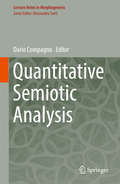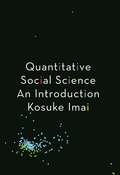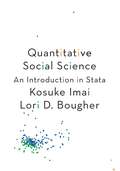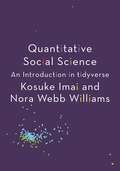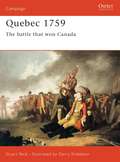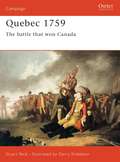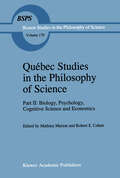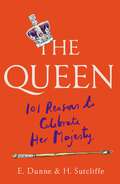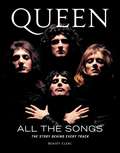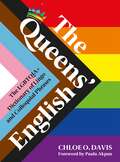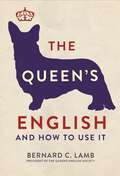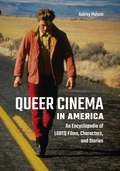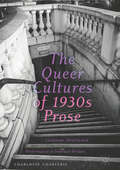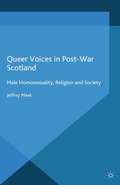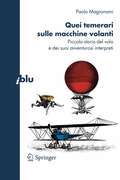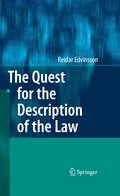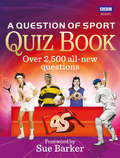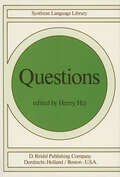- Table View
- List View
Quantitative Semiotic Analysis (Lecture Notes in Morphogenesis)
by Dario CompagnoThis contributed volume gives access to semiotic researches adopting a quantitative stance. European semiotics is traditionally based on immanent methodologies: meaning is seen as an autonomous dimension of human existence, whose laws can be investigated via purely qualitative analytical and reflexive analysis. Today, researches crossing disciplinary boundaries reveal the limitations of such an homogeneous practice. In particular, two families of quantitative research strategies can be identified. On the one hand, researchers wish to naturalize meaning, by making semiotic results interact with those coming from Neurophysiological and psychological sciences. On the other hand, statistical and computational tools are adopted to work on linguistic and multimedia corpora. The book acts to put the two approaches into dialogue.
Quantitative Social Science: An Introduction
by Kosuke ImaiAn introductory textbook on data analysis and statistics written especially for students in the social sciences and allied fieldsQuantitative analysis is an increasingly essential skill for social science research, yet students in the social sciences and related areas typically receive little training in it—or if they do, they usually end up in statistics classes that offer few insights into their field. This textbook is a practical introduction to data analysis and statistics written especially for undergraduates and beginning graduate students in the social sciences and allied fields, such as economics, sociology, public policy, and data science.Quantitative Social Science engages directly with empirical analysis, showing students how to analyze data using the R programming language and to interpret the results—it encourages hands-on learning, not paper-and-pencil statistics. More than forty data sets taken directly from leading quantitative social science research illustrate how data analysis can be used to answer important questions about society and human behavior.Proven in the classroom, this one-of-a-kind textbook features numerous additional data analysis exercises and interactive R programming exercises, and also comes with supplementary teaching materials for instructors.Written especially for students in the social sciences and allied fields, including economics, sociology, public policy, and data scienceProvides hands-on instruction using R programming, not paper-and-pencil statisticsIncludes more than forty data sets from actual research for students to test their skills onCovers data analysis concepts such as causality, measurement, and prediction, as well as probability and statistical toolsFeatures a wealth of supplementary exercises, including additional data analysis exercises and interactive programming exercisesOffers a solid foundation for further studyComes with additional course materials online, including notes, sample code, exercises and problem sets with solutions, and lecture slides
Quantitative Social Science: An Introduction
by Kosuke ImaiAn introductory textbook on data analysis and statistics written especially for students in the social sciences and allied fieldsQuantitative analysis is an increasingly essential skill for social science research, yet students in the social sciences and related areas typically receive little training in it—or if they do, they usually end up in statistics classes that offer few insights into their field. This textbook is a practical introduction to data analysis and statistics written especially for undergraduates and beginning graduate students in the social sciences and allied fields, such as economics, sociology, public policy, and data science.Quantitative Social Science engages directly with empirical analysis, showing students how to analyze data using the R programming language and to interpret the results—it encourages hands-on learning, not paper-and-pencil statistics. More than forty data sets taken directly from leading quantitative social science research illustrate how data analysis can be used to answer important questions about society and human behavior.Proven in the classroom, this one-of-a-kind textbook features numerous additional data analysis exercises and interactive R programming exercises, and also comes with supplementary teaching materials for instructors.Written especially for students in the social sciences and allied fields, including economics, sociology, public policy, and data scienceProvides hands-on instruction using R programming, not paper-and-pencil statisticsIncludes more than forty data sets from actual research for students to test their skills onCovers data analysis concepts such as causality, measurement, and prediction, as well as probability and statistical toolsFeatures a wealth of supplementary exercises, including additional data analysis exercises and interactive programming exercisesOffers a solid foundation for further studyComes with additional course materials online, including notes, sample code, exercises and problem sets with solutions, and lecture slides
Quantitative Social Science: An Introduction in Stata
by Kosuke Imai Lori D. BougherThe Stata edition of the groundbreaking textbook on data analysis and statistics for the social sciences and allied fieldsQuantitative analysis is an increasingly essential skill for social science research, yet students in the social sciences and related areas typically receive little training in it—or if they do, they usually end up in statistics classes that offer few insights into their field. This textbook is a practical introduction to data analysis and statistics written especially for undergraduates and beginning graduate students in the social sciences and allied fields, such as business, economics, education, political science, psychology, sociology, public policy, and data science.Quantitative Social Science engages directly with empirical analysis, showing students how to analyze data using the Stata statistical software and interpret the results—it emphasizes hands-on learning, not paper-and-pencil statistics. More than fifty data sets taken directly from leading quantitative social science research illustrate how data analysis can be used to answer important questions about society and human behavior.Proven in classrooms around the world, this one-of-a-kind textbook features numerous additional data analysis exercises, and also comes with supplementary teaching materials for instructors.Written especially for students in the social sciences and allied fields, including business, economics, education, psychology, political science, sociology, public policy, and data scienceProvides hands-on instruction using Stata, not paper-and-pencil statisticsIncludes more than fifty data sets from actual research for students to test their skills onCovers data analysis concepts such as causality, measurement, and prediction, as well as probability and statistical toolsFeatures a wealth of supplementary exercises, including additional data analysis exercises and interactive programming exercisesOffers a solid foundation for further studyComes with additional course materials online, including notes, sample code, exercises and problem sets with solutions, and lecture slides
Quantitative Social Science: An Introduction in tidyverse
by Kosuke Imai Nora Webb WilliamsA tidyverse edition of the acclaimed textbook on data analysis and statistics for the social sciences and allied fieldsQuantitative analysis is an essential skill for social science research, yet students in the social sciences and related areas typically receive little training in it. Quantitative Social Science is a practical introduction to data analysis and statistics written especially for undergraduates and beginning graduate students in the social sciences and allied fields, including business, economics, education, political science, psychology, sociology, public policy, and data science. Proven in classrooms around the world, this one-of-a-kind textbook engages directly with empirical analysis, showing students how to analyze and interpret data using the tidyverse family of R packages. Data sets taken directly from leading quantitative social science research illustrate how to use data analysis to answer important questions about society and human behavior.Emphasizes hands-on learning, not paper-and-pencil statisticsIncludes data sets from actual research for students to test their skills onCovers data analysis concepts such as causality, measurement, and prediction, as well as probability and statistical toolsFeatures a wealth of supplementary exercises, including additional data analysis exercises and programming exercisesOffers a solid foundation for further studyComes with additional course materials online, including notes, sample code, exercises and problem sets with solutions, and lecture slides
Quebec 1759: The battle that won Canada (Campaign)
by Gerry Embleton Stuart ReidWhat a scene!' wrote Horace Walpole. 'An army in the night dragging itself up a precipice by stumps of trees to assault a town and attack an enemy strongly entrenched and double in numbers!' In one short sharp exchange of fire Major-General James Wolfe's men tumbled the Marquis de Montcalm's French army into bloody ruin. Sir John Fortescue famously described it as the 'most perfect volley ever fired on a battlefield'. In this book Stuart Reid details how one of the British Army's consummate professionals literally beat the King's enemies before breakfast and in so doing decided the fate of a continent.
Quebec 1759: The battle that won Canada (Campaign #121)
by Gerry Embleton Stuart ReidWhat a scene!' wrote Horace Walpole. 'An army in the night dragging itself up a precipice by stumps of trees to assault a town and attack an enemy strongly entrenched and double in numbers!' In one short sharp exchange of fire Major-General James Wolfe's men tumbled the Marquis de Montcalm's French army into bloody ruin. Sir John Fortescue famously described it as the 'most perfect volley ever fired on a battlefield'. In this book Stuart Reid details how one of the British Army's consummate professionals literally beat the King's enemies before breakfast and in so doing decided the fate of a continent.
Québec Studies in the Philosophy of Science: Part II: Biology, Psychology, Cognitive Science and Economics Essays in Honor of Hugues Leblanc (Boston Studies in the Philosophy and History of Science #178)
by Mathieu Marion Robert S. CohenBy North-American standards, philosophy is not new in Quebec: the first men tion of philosophy lectures given by a Jesuit in the College de Quebec (founded 1635) dates from 1665, and the oldest logic manuscript dates from 1679. In English-speaking universities such as McGill (founded 1829), philosophy began to be taught later, during the second half of the 19th century. The major influence on English-speaking philosophers was, at least initially, that of Scottish Empiricism. On the other hand, the strong influence of the Catholic Church on French-Canadian society meant that the staff of the facultes of the French-speaking universities consisted, until recently, almost entirely of Thomist philosophers. There was accordingly little or no work in modern Formal Logic and Philosophy of Science and precious few contacts between the philosophical communities. In the late forties, Hugues Leblanc was a young student wanting to learn Formal Logic. He could not find anyone in Quebec to teach him and he went to study at Harvard University under the supervision of W. V. Quine. His best friend Maurice L' Abbe had left, a year earlier, for Princeton to study with Alonzo Church. After receiving his Ph. D from Harvard in 1948, Leblanc started his profes sional career at Bryn Mawr College, where he stayed until 1967. He then went to Temple University, where he taught until his retirement in 1992, serving as Chair of the Department of Philosophy from 1973 until 1979.
The Queen: 101 Reasons to Celebrate Her Majesty
by H. Sutcliffe E. DunneUpdated to mark her Platinum Jubilee, The Queen: 101 Reasons to Celebrate Her Majesty is a collection of all the things that make Elizabeth II a national treasure, from the profound impact she has had on 21st-century politics, to her superhuman ability to keep on waving and her fabulous collection of headscarves.Did you know that she has established a whole new dog breed, the dorgi, a cross between a corgi and a dachshund? Or that in her lifetime she has given out more than 75,000 Christmas puddings?With beautiful illustrations and humorous observations, this book is a joyful celebration of a monarch who will go down in history as one of the greatest of all time.
The Queen 1926-2022: In Her Own Words (The\little Book Of... Ser.)
by Orange Hippo!Queen Elizabeth II was much more than Britain's oldest or longest-serving monarch. Admired around the world for her serenity, wisdom and unwavering devotion to duty, she was a rock of stability in turbulent, changing times.Served by no less than 15 prime ministers, her extraordinary reign saw her visit more than 100 countries as she rubbed shoulders with powerful leaders and influential thinkers. And as Britain's empire declined, she pledged her 'heart and soul' as Head of the Commonwealth, made up of 54 richly diverse countries.The 170 quotes inside capture the queen's personal reflections on everything from history, world affairs and the monarchy to service, sacrifice and the family. Teeming with inspirational words and pearls of royal wisdom, this book is a fitting tribute to a much cherished sovereign.
Queen All the Songs: The Story Behind Every Track (All the Songs)
by Benoît ClercFilled with fascinating photographs (some rarely seen), and juicy behind-the-scenes details, Queen All the Songs details the unique recording history of the mega-bestselling and hugely influential rock band, album by album and track by track. A lovingly thorough dissection of every album and every song ever released by the beloved rock group, Queen All the Songs follows Freddie, Brian, Roger, and John from their self-titled debut in 1973 through the untimely passing of Freddie, all the way up to their latest releases and the Oscar-winning film, Bohemian Rhapsody. The writing and recording process of each and every track is dissected, discussed, and analyzed by author Benoît Clerc, and page after page features fascinating and sometimes rarely seen images of the band. Queen All the Songs delves deep into the history and origins of the band and their music. This one-of-a-kind book draws upon decades of research and recounts the circumstances that led to the composition of every song, as well as the recording process, and the instruments used. Featuring hundreds of photographs, including rare black-and-white publicity stills, images of instruments used by the band, and engaging shots of the musicians in-studio, Queen All the Songs is the must-have book for any true fan of classic rock.
The Queens' English: The LGBTQIA+ Dictionary of Lingo and Colloquial Expressions
by Chloe O. DavisA landmark reference guide to the LGBTQIA+ community's contributions to the English language-an intersectional, inclusive illustrated glossary featuring more than 800 terms created by and for queer culture.With a foreword from Paula Akpan Do you know where "yaaaas queen!" comes from? Do you know the difference between a bear and a wolf? Do you know what all the letters in LGBTQIA+ stand for? The Queens' English is a comprehensive guide to modern gay slang, queer theory terms, and playful colloquialisms that define and celebrate LGBTQIA+ culture. This modern dictionary provides an in-depth look at queer language, from terms influenced by celebrated lesbian poet Sappho and from New York's underground queer ball culture in the 1980s to today's celebration of RuPaul's Drag Race. The glossary of terms is supported by full-color illustrations and photography throughout, as well as real-life usage examples for those who don't quite know how to use "kiki," "polysexual," or "transmasculine" in a sentence. A series of educational lessons highlight key people and events that shaped queer language; readers will learn the linguistic importance of pronouns, gender identity, Stonewall, the Harlem Renaissance, and more. For every queen in your life-the men, women, gender non-conforming femmes, butches, daddies, and zaddies-The Queens' English is at once an education and a celebration of queer history, identity, and the limitless imagination of the LGBTQIA+ community.
The Queen's English: And How to Use It
by Bernard C. Lamb'Having been asked many times if he could recommend a definitive guide to use of our glorious language and not satisfied that the right book existed, Lamb wrote it himself' - Yorkshire PostWritten by the President of the Queen’s English Society and covering all of the basics, this clear and practical guide will teach anyone how to write and use English correctly.What is good English, and why do we need it? The Queen's English shows how the English language, used properly, has great power to instruct, move and entertain people, but used incorrectly, can lead to a lack of clarity and confusion.This book informs in a light-hearted way, reminding readers how to use the basics of grammar, punctuation and spelling, as well as further teaching them new tips and tricks of style, rhetoric, vocabulary and the use of foreign phrases, to give their writing and speech a stylish and impressive flair.The book also shows the perils of using language incorrectly, offering extremely (if unintentionally) humorous examples of where bad English can cause one thing to mean something entirely different!Authoritative yet entertaining, and illustrated with pithy drawings, this is the ideal book for anyone who strives for clear, stylish and accurate communication.
Queer Cinema in America: An Encyclopedia of LGBTQ Films, Characters, and Stories
by Aubrey MaloneThis reference helps readers navigate the perilous odyssey those of an LGBTQ orientation had to face in an age less enlightened than our own, when an attraction to members of the same gender could lead to horrendous abuse.Just as American society has changed dramatically from decade to decade, so has queer cinema. Taking us from a time when LGBTQ characters were often represented as either caricatures or figures of farce, this lively yet authoritative reference explores the sea change ushered in by such stars as Greta Garbo and Marlene Dietrich in the 1930s and '40s, androgynous figures such as Montgomery Clift, James Dean, and Marlon Brando in the '50s, and closeted gay men such as Rock Hudson and Liberace, whose double lives were exposed by the scourge of AIDS.Included are alphabetically arranged entries on stars, directors, films, themes, and other topics related to queer cinema in America, including films and persons from outside the U.S. who nonetheless figured prominently in America popular culture. Entries cite works for further reading, sidebars provide snippets of interesting trivia, a timeline highlights key events, and a selected, general, end-of-work bibliography cites the most important major works on the topic.
Queer Cinema in America: An Encyclopedia of LGBTQ Films, Characters, and Stories
by Aubrey MaloneThis reference helps readers navigate the perilous odyssey those of an LGBTQ orientation had to face in an age less enlightened than our own, when an attraction to members of the same gender could lead to horrendous abuse.Just as American society has changed dramatically from decade to decade, so has queer cinema. Taking us from a time when LGBTQ characters were often represented as either caricatures or figures of farce, this lively yet authoritative reference explores the sea change ushered in by such stars as Greta Garbo and Marlene Dietrich in the 1930s and '40s, androgynous figures such as Montgomery Clift, James Dean, and Marlon Brando in the '50s, and closeted gay men such as Rock Hudson and Liberace, whose double lives were exposed by the scourge of AIDS.Included are alphabetically arranged entries on stars, directors, films, themes, and other topics related to queer cinema in America, including films and persons from outside the U.S. who nonetheless figured prominently in America popular culture. Entries cite works for further reading, sidebars provide snippets of interesting trivia, a timeline highlights key events, and a selected, general, end-of-work bibliography cites the most important major works on the topic.
The Queer Cultures of 1930s Prose: Language, Identity and Performance in Interwar Britain
by Charlotte CharterisOffering a radical reassessment of 1930s British literature, this volume questions the temporal limits of the literary decade, and broadens the scope of queer literary studies to consider literary-historical responses to a variety of behaviours encompassed by the term ‘queer’ in its many senses. Whilst it is informed by the history of sexuality in twentieth-century Europe, it is also profoundly concerned with what Christopher Isherwood termed ‘the market value of the Odd.’ Drawing, for its methodology, on the work of Raymond Williams, it traces the impact of the Great War on the development of language, examining the use of ten ‘keywords’ in the prose of Christopher Isherwood, Evelyn Waugh and Patrick Hamilton, and that of their respective literary milieux, in order to establish how queer lives and modern sub-cultural identities were forged collaboratively within the fictional realm. By utilizing contemporary perspectives on performativity in conjunction with detailed close readings it repositions these authors as self-conscious agents actively producing their own queer masculinities through calculated acts of linguistic transgression.
Queer Voices in Post-War Scotland: Male Homosexuality, Religion and Society (Genders and Sexualities in History)
by J. MeekThis book examines the experiences of gay and bisexual men who lived in Scotland during an era when all homosexual acts were illegal, tracing the historical relationship between Scottish society, the state and its male homosexual population using a combination of oral history and extensive archival research.
Queering Autoethnography
by Stacy Holman Jones Anne M. HarrisQueering Autoethnography articulates for the first time the possibilities and politics of queering autoethnography, both in theoretical terms and as an intervention into narratives and cultures of apology, shame and fear. Despite the so-called mainstreaming of same-sex relationships and trans* visibility, many within gender’s ‘liminal zone’ remain invisible and unrecognized, existing somewhere outside of heteronormative relationships and institutions. At the same time, the political and scholarly potential of autoethnography is expanding, particularly in its potential to evoke empathic and affective responses at a time of public numbness, a practice crucial to making scholarly research relevant to the work of global citizenship and crafting meaningful lives. This volume considers flash points in contemporary scholarly and popular culture such as queer memorializing and mourning; unintelligibility and monstrosity; physical, digital and cultural transformations of queer lives and bodies; the power and danger wrought in the public assembly of queer people in a culture of massacre; and the promise of queer futurities in the contemporary moment. It also makes original theoretical contributions that include concepts such as massacre culture, queer terror, mundane annihilations, and activist affect. The authors write these ideas in action, joining theory and story as a contact zone for analysis, critique and change.
Queering Autoethnography
by Stacy Holman Jones Anne M. HarrisQueering Autoethnography articulates for the first time the possibilities and politics of queering autoethnography, both in theoretical terms and as an intervention into narratives and cultures of apology, shame and fear. Despite the so-called mainstreaming of same-sex relationships and trans* visibility, many within gender’s ‘liminal zone’ remain invisible and unrecognized, existing somewhere outside of heteronormative relationships and institutions. At the same time, the political and scholarly potential of autoethnography is expanding, particularly in its potential to evoke empathic and affective responses at a time of public numbness, a practice crucial to making scholarly research relevant to the work of global citizenship and crafting meaningful lives. This volume considers flash points in contemporary scholarly and popular culture such as queer memorializing and mourning; unintelligibility and monstrosity; physical, digital and cultural transformations of queer lives and bodies; the power and danger wrought in the public assembly of queer people in a culture of massacre; and the promise of queer futurities in the contemporary moment. It also makes original theoretical contributions that include concepts such as massacre culture, queer terror, mundane annihilations, and activist affect. The authors write these ideas in action, joining theory and story as a contact zone for analysis, critique and change.
Quei temerari sulle macchine volanti: Piccola storia del volo e dei suoi avventurosi interpreti (I blu)
by Paolo MagionamiNel giugno del 1783 i fratelli Montgolfier aprirono la via delle nuvole con un mezzo “più leggero dell’aria”, la mongolfiera; 120 anni dopo, altri due fratelli, Wilbur e Orville Wright, conquistarono la terza dimensione con un mezzo “più pensate dell’aria”, l’aeroplano. Due modi differenti per raggiungere quello che Wilbur definì “il più grande desiderio dell’umanità”: volare. In questa breve storia del volo, vengono raccontate le gesta di quanti con ardore e follia, criterio e scelleratezza hanno tentato la via dei cieli: sono quei temerari che per guadagnarsi il sogno hanno messo in conto ossa rotte e cadute rovinose. Di alcuni è rimasta la gloria e il ricordo scolpito nella storia, ad altri un nome perduto nelle cronache di un tempo che fu. E quando a inizio Novecento si diffondono i primi brevetti di pilota, l’era pionieristica del volo inizia a volgere al termine. Ma per quei temerari a bordo di macchine volanti questo significa solo compiere imprese sempre più ardite lungo la via delle nuvole.
The Quest for Core Values in the Application of Legal Norms: Essays in Honor of Mordechai Kremnitzer
by Khalid Ghanayim Yuval ShanyRelations between societal values and legal doctrine are inevitably complex given the time lag between law and social reality, and the sociological space between legal communities involved in the development and application of the law and non-legal communities affected by it. It falls on open-ended concepts, such as proportionality, human rights, dignity, freedom, and truth, and on legal frameworks for balancing competing rights and interests, such as self-defense, command or corporate responsibility, and restrictions on freedom of expression, to negotiate chronic tensions between law and society and to bridge existing gaps. The present volume contains chapters by leading experts – former judges on constitutional courts and international courts, and some of the world’s leading criminal law, public law, and international law scholars – offering their points of view and professional analysis of legal notions and doctrines that serve as hubs for the interpretation, application, and contestation of core values, which in turn constitute building blocks of the rule of law. The shared perspective on the interplay between values and legal rules in public law, criminal law, and international law is likely to render the publication a valuable resource for both theoreticians and practitioners, law students, and seasoned legal experts working in diverse legal fields.
The Quest for the Description of the Law
by Reidar EdvinssonMy dissertation for LLD (or JSD) Att beskriva rätten (To Describe Law), which was written under my bachelor surname of Andréasson, was presented for public exa- nation on Nov 4, 2004. Since then the text has been developed in two separate directions. On the one hand, three of the chapters have been made more accessible to students of jurisprudence and have been included in the second edition of the te- book Rättsfilosofi, samhälle och moral genom tiderna edited by Joakim Nergelius. On the other hand, the whole dissertation has been revised, translated and published as the present book. In the time that has passed since my dissertation, many things have changed. On the personal level, my friend and tutor, Aleksander Peczenick, was sadly taken away from my circle of colleagues. In contrast to that sad event, I have spent two nine-month periods on paternity leave, raising my two children, Selma and Bernhard. This past year, I have decided to move from theory to practice and have started working in a court of law. During my work on the dissertation, I had the opportunity to spend a rewarding term at Rutgers University in Camden, NJ visiting Professor Dennis Patterson. Since this book is a continuation of that project, it feels appropriate to repeat my thanks to Professor Patterson and STINT (The Swedish Foundation for International Cooperation in Research and Higher Education) for making that visit possible.
A Question of Sport Quiz Book
by David Gymer David BallAfter more than four decades on the air, A Question of Sport is firmly established as the final word in sports trivia. Now, after countless arguments, sporting debates and lost hours spent directing the action from the sofa, you can finally test your own knowledge to see if you can succeed where so many sporting greats have failed.With over 3,500 brand new questions, A Question of Sport Quiz Book will challenge you to put your money where your mouth is and put your knowledge of the sports world to the ultimate test. Play on your own or in teams to answer questions covering all eras of football, golf, cricket, motor racing, boxing, rugby, darts, snooker, the Olympics and so much more.With questions from your favourite rounds from A Question of Sport, here at last is your chance to take on the captain's challenge, or go head-to-head on the quick-fire buzzer round. What will be your score when the final whistle blows?
Questions (Studies in Linguistics and Philosophy #1)
by H. HizTo the philosopher, the logician, and the linguist, questions have a special fascination. The two main views of language, that it describes the world, and that it expresses thought, are not directly applicable to questions. Ques tions are not assertions. A question may be apt, sharp, to the point, impor tant, or it may be inappropriate, ambiguous, awkward, irrelevant or irreverent. But it cannot be true or false. It does not have a truth value not just because an utterance like Was the letter long? does not indicate which letter is being talked about. The indicative The letter was not long has the same indeter minacy. In actual context the anaphoric definite article will be resolved both for a question and for an indicative sentence. Contextual resolutions are easily found for most cross-references. A question cannot be either true or it does not describe a state of affairs. Neither does it express false, because thought, because it is an expression of suspended thought, of lack of judge ment. To dress it in other philosophical styles, a question is not a judgment, it is not a proposition, it is not an assertion. A philosopher may try to paraphrase a question as an indicative sentence, for instance as a statement of ignorance, or as a statement of the desire to know. Hintikka, Wachowicz and Lang explore this territory. Or he may interpret it as a meta statement intimating the direction in which the flow of the discourse is going.
Questions and Answers on Family Health: The Alternative Approach
by Jan De VriesThis is the handbook for every household and is published in direct response to public demand. In this volume Jan de Vries uses all of his vast wealth of experience to answer hundreds of questions which have consistently been asked of him over the years, from varicose veins to the use of vitamin E, headaches to verrucae, from air and water pollution to ME, candida and other present-day problems. The foreword to this invaluable, easy-to-use reference guide is by Dr Alfred Vogel, author of the million-selling Nature Doctor and himself mentor to Jan de Vries.
